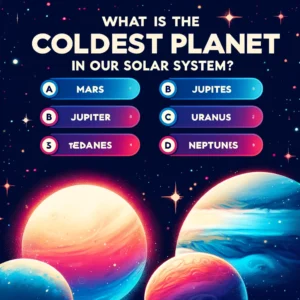What is the coldest planet in our solar system?
A) Mars
B) Jupiter
C) Uranus
D) Neptune
Correct Answer: C
Exploring the Coldest Planet in Our Solar System:
When we think about the solar system, planets like Mars or Jupiter often capture the public imagination because of their distinctive features and scientific intrigue. However, when it comes to extreme conditions, Neptune holds a particularly frosty distinction—it is the coldest planet in our solar system. Let’s dive into some intriguing details about this distant, icy giant.

Neptune has the coldest average surface temperature among the planets, generally around -214 degrees Celsius (-353 degrees Fahrenheit). However, Uranus holds the record for the lowest temperature ever recorded in the solar system, which is about -224 degrees Celsius (-371 degrees Fahrenheit). This makes Uranus the planet with the coldest recorded temperature, despite being closer to the sun than Neptune.
The reason for Uranus’s extreme cold, despite its proximity to the Sun compared to Neptune, is not fully understood. It’s thought that its significant axial tilt and possibly the result of a massive collision long ago, which might have affected its internal structure, contribute to its lower temperatures (The Nine Planets) (WorldAtlas) (Wikipedia).
The Remote Ice Giant:
Neptune is the eighth planet from the Sun, orbiting at a distance of about 4.5 billion kilometers (about 2.8 billion miles). This remoteness from the Sun means it receives very little solar energy, making it not only one of the least studied but also the coldest planet we know of within our solar neighborhood.
Neptune’s Icy Temperatures:
The average temperature on Neptune is a chilling -214 degrees Celsius (-353 degrees Fahrenheit). These temperatures are so low that the methane in its atmosphere condenses to form ice clouds, a characteristic that contributes to its striking blue appearance when viewed through telescopes. The planet’s extreme cold is attributed to its distance from the Sun and its position in the outer reaches of the solar system, where sunlight is over 900 times less intense than at Earth.
Atmospheric Conditions:
Despite its frigid temperatures, Neptune is a world of surprising atmospheric activity. It has some of the strongest wind speeds observed in the solar system, with gusts reaching up to 2,100 kilometers per hour (about 1,300 miles per hour). These winds whip around the planet at high speeds, partly due partly to the small amount of heat Neptune still retains from its formation 4.5 billion years ago and partly due to radioactive heating in its core.
Neptune’s Role in Our Understanding of the Solar System:
Studying Neptune helps scientists learn more about the outer planets and the history of our solar system. It’s particularly important for understanding the formation of similar ice giants and exoplanets in other solar systems. Despite the challenges posed by its distance, missions like Voyager 2 (which flew by Neptune in 1989) and the upcoming James Webb Space Telescope are crucial for providing insights into its composition, weather patterns, and the dynamics of its moons and rings.
Conclusion:
Neptune’s title as the coldest planet in our solar system highlights not just the extremes that exist within our own cosmic neighborhood but also the diversity of planetary environments. Every discovery about Neptune opens up more questions about the nature of the universe and encourages ongoing interest and research in astronomy and space exploration.

2 thoughts on “What is The Coldest Planet”